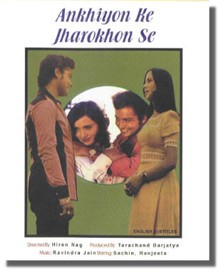
|
|
Producer: Tarachand Barjatya Director: Hiren Nag Starring: Ranjeeta, Sachin Music: Ravindra Jain Lyrics: Ravindra Jain Singers: Hemlata, Shailendra Singh, Ravindra Jain, Jaspal Singh. Audio On: HMV Number of Songs: 7 Released in: 1978 |
Reviewed by: Shahid Khan Reviewer's Rating: 8 out of 10 |
 Hemlata is hardly seen on the Hindi film music scene nowadays. In the 1970�s, she gave us some unforgettable pearls in her exquisite voice. She enchanted millions, and continues to do so, with her magnificent velvety voice rich in emotion and expression.
Hemlata is hardly seen on the Hindi film music scene nowadays. In the 1970�s, she gave us some unforgettable pearls in her exquisite voice. She enchanted millions, and continues to do so, with her magnificent velvety voice rich in emotion and expression.
The title song of �Ankhiyon Ke Jharokon Se� is her masterpiece. While Ravindra Jain and Hemlata have worked on many other exceptional songs, this is easily their best one together. This was hailed as the most popular song of 1978 by �Binaca Geetmala� (a radio show that used to compile records of album sales). The number is a beautiful concoction of melody and soulful lyrics. The words strike a chord because they are about fear of being separated from your beloved one. And yet she realises that she has nothing to fear because her beloved will always be there with her in her thoughts and her heart. �Tum door nazar aaye, Badi door nazar aaye, Band karke jharokhon ko, Zara baithi jo sochne, Mann main tumhi muskaaye�. But fear never really disappears. With a lot of hope and praying comes the fear that one day there might not actually be anything left to hope for. �Din raat dua maange, Mera mann tere vaaste, Kabhi apni umeedon ka, Koi phool na murjaaye.�
The above song is very well known and Hemlata�s rendition is out-of-this-world but I am always more affected by the two shorter versions, �Ankhiyon Ke Jharokon Se (Part II)� and �Ankhiyon Ke Jharokon Se (Part III)�. Get your tissues out as Hemlata�s tearfully assesses the distress of her situation (for the female character in the film who is afflicted with cancer). Like a flower trying to hold on to her garden in the middle of a ferocious storm, the lyrics portray a woman who is on the verge of emotional breakdown but struggling to stay happy on the outside for the sake of her beloved. A touching image is created from Hemlata�s powerfully stirring voice, that of tears being on the tips of a young woman�s eyelashes but never actually running down her soft cheeks. �Part II� is the most moving while �Part III� has a slightly more optimistic message and so has a chorus joining in this time.
Ravindra himself takes the mike for �Jaate Huye Yeh Pal Chin�. Sometimes, big egos can be the main reason why a lot of music directors make unsuitable decisions (i.e. choosing themselves to sing) regarding certain songs. This is definitely not a wrong decision here; Ravindra reveals his hidden talent for singing. His voice has that soothing and aromatic quality to it.
Hemlata pairs up with Shailendra Singh for two romantic duets in this album. Their pairing is a refreshing one. Hemlata�s honeyed voice contrasts very well against the textured voice of Shailendra�s. �Kahi Din Se Mujhe� is just charming and idyllic. The best parts are when both the artists sing together, it is ravishing the way that both of their voices intertwine. A dreamy track, the song evokes images of a secluded paradise where two lovebirds roam free content with each other�s company. �Ek Din Tum Bahut Bare Banoge, Ek Din�� could have been a great song but it suffers from the English lyrics syndrome. The way the English words are rendered by the singers will either make you cringe or laugh. I have no idea why on earth English words are used here, they could have easily been replaced by Hindi. It makes you realise how today�s singers (Sunidhi Chauhan, K.K.) are so much better at singing English words.
Hemlata�s final duet is with Jaspal Singh in �Dohavali� (also known as �Bade Badai Na Kar�). While the singing is very good, this religious song is not much fun to listen to. The tune is too restrained and too under-developed. It would have been nice if Ravindra had occasionally strayed away from the main tune. But the song goes on and on, sounding like a stuck record. I suspect many people may like this one but it is not to my taste.
A blind man who struggled to get to the top, Ravindra Jain is an inspiration for other struggling artists out there. His most well known works are mostly for the small Rajshri productions. If you like �Ankhiyon Ke Jharokhon Se�, take the time out to listen to �Chitchor� and �Dulhan Wohi Jo Piya Man Bhaye�. I guarantee that you won�t be disappointed!